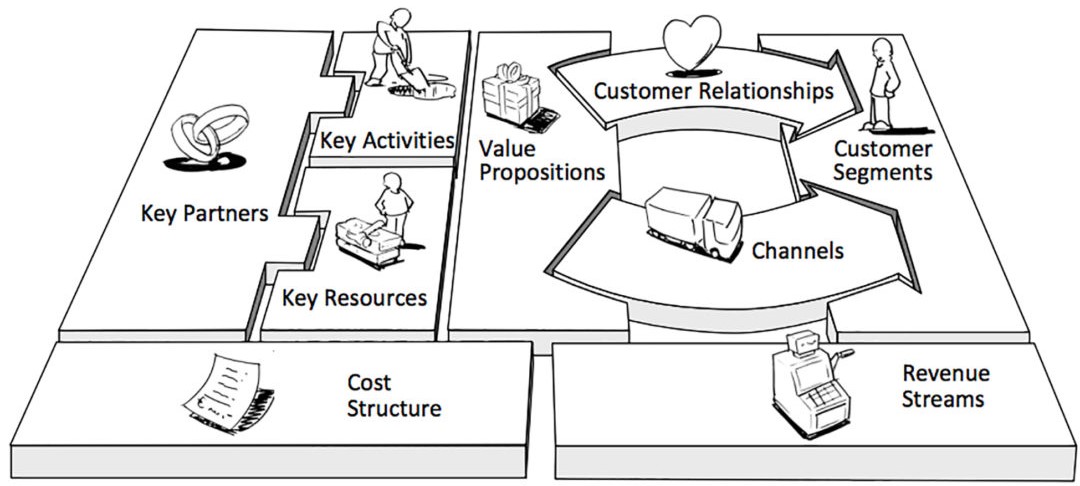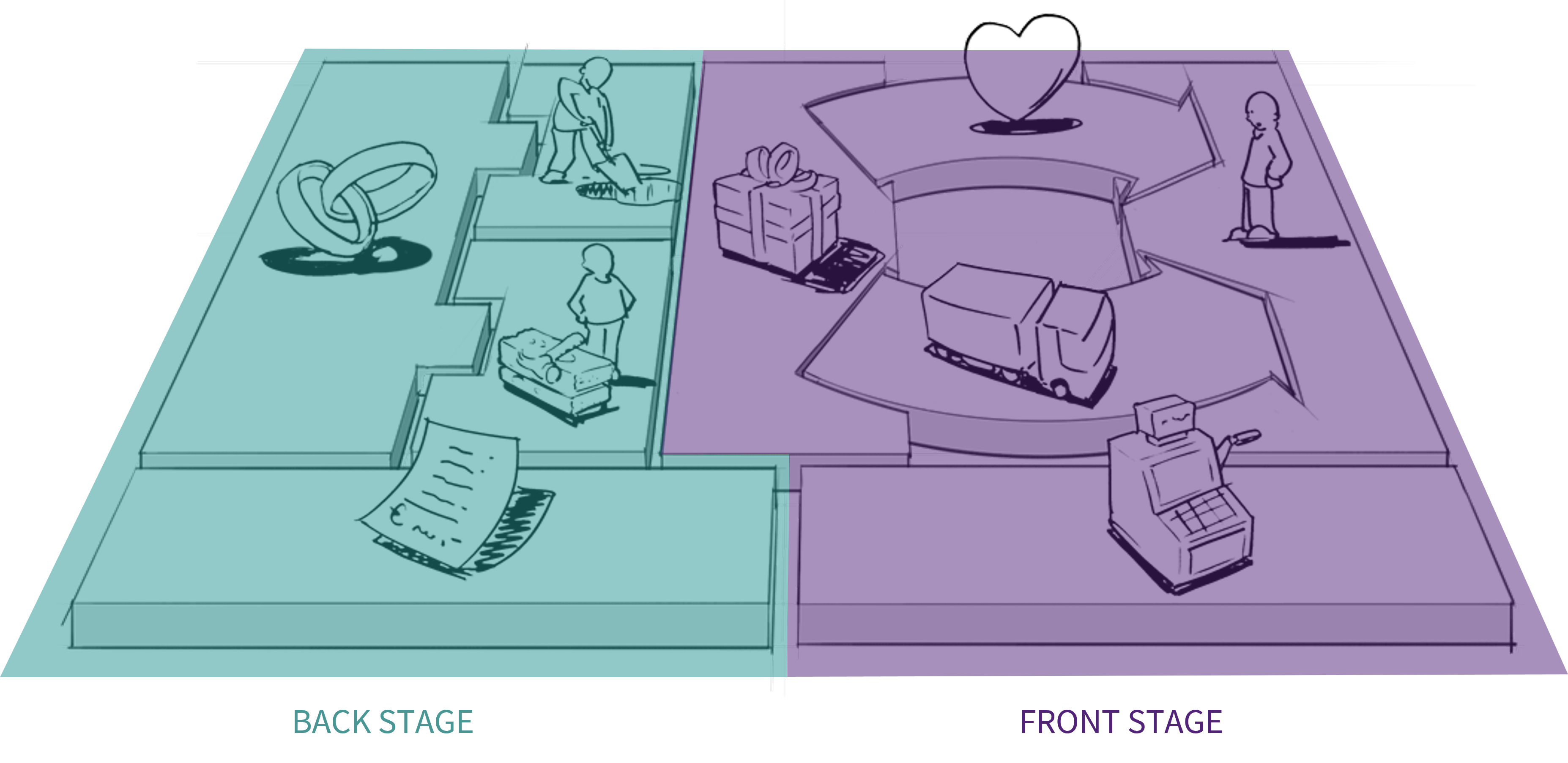Business model canvas#
In this chapter, we look at the business model canvas, which is a simple yet useful tool for describing and visualising a business model.
Business models and customer development#
The lovely model below in Fig. 7, thanks to Alexander Osterwalder from Strategyzer, gives us an overview of the nine key parts of a business model, and how they relate.

Fig. 7 Overview of the business model canvas. Source: https://www.strategyzer.com/#
Let’s define each of these:
Customer segments define one or more groups of people who (we think) will be our customers, and a description of the problems that they are experiencing related to our vision. Typically, very few products appeal to everyone because people don’t all have the same problems. Instead we look at groups of people who share some properties. We can define customer segments based on their occupation, hobbies, demographics (e.g. age, location, gender, sexuality, etc.), living situation (alone, share house, family house, renting, owner), and many others. We specify what the problems are for each of these segments. For this, we need to answer the question: “Who are our customers and what are their problems?”
Value propositions are statements (either guesses or verified insights) that describe how to solve customer problems. For this, we need to answer the question: “What are the solutions that we can make to solve our customers’ problems in each segment?”
Channels are the mechanisms by which solutions are delivered to customers; e.g. a web application, via distribution to small businesses, via YouTube. For this, we need to answer the question: “How do our customers in each segment want to be reached to learn about this and use it?”
Customer relationships are the mechanisms that are used to engage and build trust between organisations and customer segments. These may be different for different customer segments. For this, we need to answer the question: “How do our customers want to interact with us and how do we want them to ‘see’ us?”
Revenue streams are identify how value propositions will result in revenue from the customer segments to the organisation. For this, we need to answer the question: “Which value propositions are customer segments willing to pay, and how much?”
Key resources identify what is needed to successfully deliver our value propositions; e.g. cloud services, physical resources (delivery vehicles, hardware, etc.), service subscriptions. For this, we need to answer the question: “What are the resources required to deliver our value propositions?”
Key activities identify what is need to be done to successful deliver our value propositions. For this, we need to answer the question: “What are the things we need to do to deliver our value propositions?”
Key partners identify groups outside of the organisation that help the product to be successful; e.g. suppliers, distributors, etc. These are typically people or organisations who can help do key activities, or give access to key resources. If we look at our channels, often we see that the delivery is via indirect channels, meaning not via us directly, but via another organisation. These organisations are partners. For this, we need to answer the question: “Who are the people we need to work with to deliver our value propositions?”
Cost structures identify the expenses that are needed to operate; e.g. for salaries, rent, utilities, services, and technology. For this, we need to answer the question: “What are the costs that we will incur to deliver our value propositions?”
At each point, any of these could be either a hypothesis (a guess that we have made using some assumptions) or an insight based on data (something we have gone out and verified).
We can see that this is customer focused, not product focused. It targets the problems of the customers directly.
Will we need to do all of these in this course?
In this course, we will focus mostly on the first five items:
Customer segments: who are our customers?
Value propositions: what can we do for them?
Channels: how will we deliver our product/service?
Customer relationship: how do we interact with our customers?
Revenue streams: will customer pay for it? If yes, how?
These are the so-called front stage of the business model canvas. The remaining steps 6-9 are called the back stage of the business model canvas. See Fig. 8.

Fig. 8 Front stage vs. back stage of a business model canvas.#
The back stage activities are crucial in building and scaling a business. We will be discussing these but will only have time to scratch the surface in going out and verifying them.
The business model canvas#
Definition — Business model canvas (BMC)
A business model canvas is a visual description of the nine key parts of a business model. It consists of (a mix of) hypotheses and facts about the business model. It can be used to describe existing business models, describe new business models, and to help us focus on the key questions of a new business.
Fig. 9 shows the structure of a business model canvas. We can see that this aligns with the overview in Fig. 7.

Fig. 9 The structure of a business model canvas. Source: https://www.strategyzer.com/#
The business model canvas is something that we should complete for any innovation project. The value of a business model canvas is not just in having it (although it is useful to visualise our business model). The value comes in the doing the activities that we need to fill out the different sections. By asking the right questions and gathering the right data to fill in the canvas, we learn about our customers, their problems, what we can do to solve, and what we need to solve them.
We do not need to use this format directly – business models canvases can just be represented on pieces of paper, as notes on a Miro board, as cards on a Trello board, or as activities on a Jira board. However, the format in Fig. 9 allow us to easily visualise the core components on our business model, so can be useful to get a high-level snap shot and to help other people (e.g. investors, collaborators) quickly understand the business model.
Further, this format of the canvas has been designed carefully so that the related parts of the model are next to each other. For example, value propositions serve customer segments, but they do so via customer relationships and channels; the key activities and key resources are required to deliver value propositions; and so on.
Customer development and the business model canvas#
Effectively, the customer development process is what helps us to “fill out” our business model canvas.
Focusing on customer discovery, we start with our vision, and brainstorm a set of hypotheses around our vision. We should have at least one in each of the cells of the business model canvas — and often, multiple. There is no set number of even “common” number of hypotheses – it depends on your vision and what you have found. Typically though, the number in each cell is just a handful (2-7) in each cell, with customer segments and value propositions often containing more than others – many value propositions can be ‘delivered’ using the same activities and resources.
Customer development helps us to do three main things:
Turn some of our hypotheses that into verified hypotheses (sometimes called “facts”), which effectively means that we collect enough data such that we are confident that our hypotheses (our guesses) are accurate.
Turn some of our hypotheses into into rejected hypotheses, which effectively means that we collect enough data such that we are confident that our hypotheses (our guesses) are inaccurate.
Create new hypothesis out of what we learn.
Throughout these course, the business model canvas and the related value proposition canvas are used focus to guide what we do. We express what we think is true (hypotheses), we add them to the canvases, we test them by experimentation, and then we iterate until we have a business model canvas with a set of accepted hypotheses that are sufficient for us to move on to the next step.
Takeaways#
Takeaways
Business model canvases are a way to understand and represent business models.
They are customer focused.
A business model canvas can be separated into front stage (things the customer sees) and back stage (things the customer does not see).
We use the business model canvas as a way to guide our thinking and our activities, as well as a way to represent and visualise what we have found.
